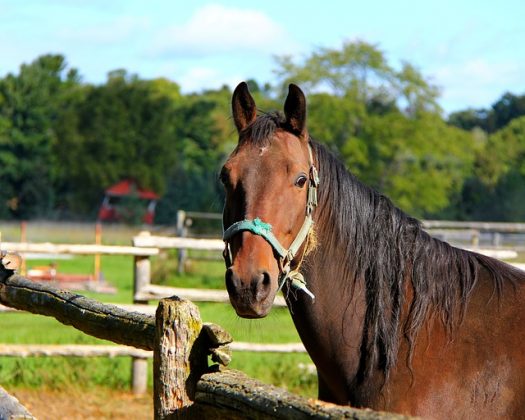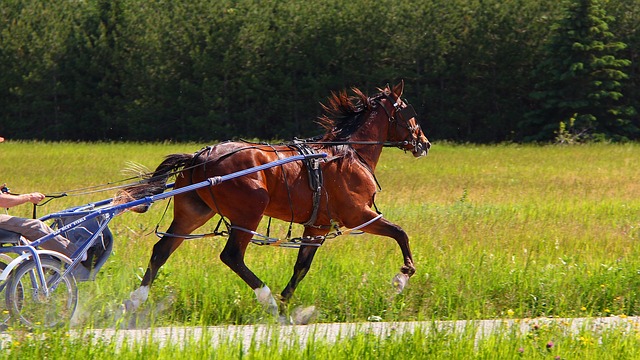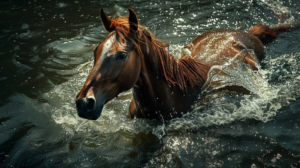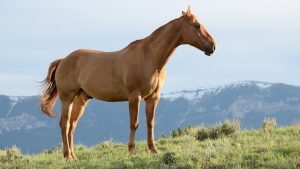Both the Standardbred and the American Saddle Horse are the result of a Thoroughbred top cross on native mares; both are truly American creations—the former developing as a road horse in the East and the latter as a saddle horse of the southern plantations. In each case, the descendants of one Thoroughbred individual dominated the breed.
Messenger, imported in 1788, largely shaped the Standardbred through his great-grandson, Hambletonian 10; whereas Denmark, foaled in 1839, largely determined the destiny of the American Saddle Horse through his illustrious son, Gaine’s Denmark. Despite these similarities in background, two very different breeds evolved because of the differences in the native mares used, and selection as influenced by the respective ends in view.
standardbred horse.

In the case of the Standardbred, the native foundation mares were trotters or pacers adapted to fast driving in harness; whereas the native mares used in molding the American Saddle Horse were amblers, easy to ride.
Origin and Native Home
The Standardbred, originally developed for road driving and racing, descended from five sources: (1) the Thoroughbred, (2) the Norfolk Trotter or Hackney, (3) the Arabian and Barb, (4) the Morgan, and (5) certain pacers of mixed breeding. Originally this breed was often referred to as the American Trotter, but this designation is now discarded because the breed embraces both trotters and pacers, all of which are registered in the same association.
The name “Standardbred” is derived from the fact that, beginning in 1879, eligibility for registration was based on the ability of the animal to trot the mile at 2:30 or pace the same distance at 2:25. Today, a record of performance is no longer a prerequisite to registration—it is merely necessary that animals be the offspring of recorded sires and dams.
The great pillar of the Standardbred was Rysdyk’s Hambletonian, or Hambletonian 10 (the latter designating his Standard number in Vol. IV of the Register). This great stallion, foaled in 1849, carried the blood of Messenger, a gray Thoroughbred stallion imported from England to Philadelphia in 1788 at the age of eight, and Bellfounder, a Norfolk Trotter or Hackney, foaled in England in 1815 and imported to Boston in 1822.
No breed can boast of a greater sire than Hambletonian 10. During his 21 years in the stud, he sired 1,321 foals, and so famous did he become by virtue of the speed of his get that his service fee was placed at $500.
Standardbred Characteristics
In general, animals of this breed are smaller, longer bodied, less leggy and possess less quality than the Thoroughbred, but they show more substance and ruggedness and they possess a more tractable disposition. The head, ears, and bone show less refinement, and the hind legs are not quite so straight as in the Thoroughbred. Standardbred animals attain speed through ability to extend themselves into long strides, repeated rapidly, because of the long forearm and long, narrow muscles.
In weight, the Standardbred ranges from 900 to 1,300 pounds, and in height from 15 to 16 hands, with the average being around 15-2 hands. Bay, brown, chestnut, and black are the most common colors; but grays, roans, and duns are found. Though possessing a common ancestry, some families produce a much larger proportion of pacers than others. Many individuals show speed at both gaits. Shoeing and training are also important factors in determining whether an animal shall be a trotter or a pacer.
Adaptation and Use
As previously indicated, the Standardbred was primarily originated as a trotting horse and for the purpose of providing a superior road horse in the days of the horse and buggy. He was first put under saddle and eventually into harness hitched to a sulky.
With the coming of improved highways and the automobile, the progressive breeders. ever alert to new developments, turned their attention almost exclusively to the production of a speedy harness racehorse—either at the trot or the pace. The gameness and stamina of the Standardbred is unexcelled, thus adapting him to race heats wherein it is necessary that he go mile after mile at top speed.
Animals of this breed are also exhibited as light harness horses in the great horse shows of the land. The early foundation animals of the Standardbred contributed to the development of the American Saddle Horse and the Tennessee Walking Horse. Many hunters are also of Standardbred extraction. It may be said that the Standardbred has proved to be a valuable utility horse—animals of such extraction having speed, endurance, and a tractable disposition.





